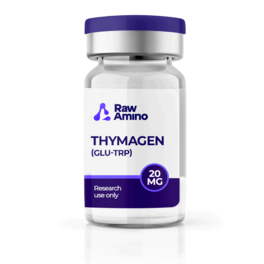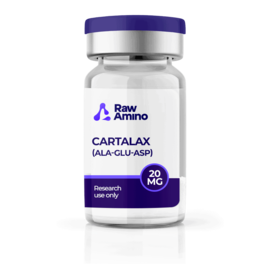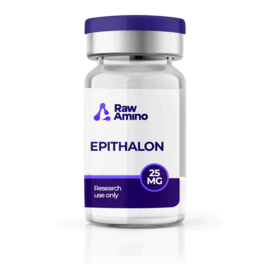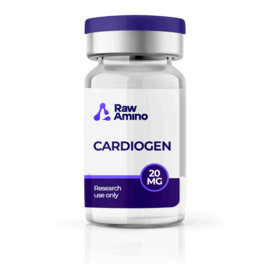Pinealon – 20MG
$69.00
Discount per Quantity
| Quantity | Discount | Price |
|---|---|---|
| 5 - 8 | 5% | $65.55 |
| 9 + | 10% | $62.10 |
Scientific Overview of Pinealon
Pinealon, also known as EDR, is a synthetic tripeptide classified among Khavinson’s group of short peptides. Derived in part from earlier studies involving crude polypeptide extracts such as Cortexin, Pinealon has attracted scientific attention due to its small size and potential for unique intracellular activity. Unlike many peptides that act primarily through cell surface receptors, Pinealon appears to bypass these typical interactions, with research suggesting that it may penetrate both cellular and nuclear membranes. This proposed direct access to DNA positions it as a candidate for exploration in studies of gene expression and genomic regulation.
The peptide has been considered within frameworks relating to neuronal resilience, oxidative stress, circadian rhythm stability, and cellular metabolism. Laboratory investigations suggest that Pinealon may influence stress responses and contribute to protective cellular behaviors under conditions such as hypoxia or oxidative load. Its reported interactions with key signaling systems, as well as with potential gene promoter regions, highlight its growing importance in molecular biology research.
Alternative Names: EDR, Glutamylaspartylarginine, T-33 peptide
Pinealon Studies and Research Data
Research on Neuronal Stress and Protection
Scientific investigations have suggested that Pinealon may support neuronal resilience in models exposed to oxidative stress or hypoxic conditions. Experiments in rat models indicated a potential reduction in reactive oxygen species buildup and associated cell damage, while cell-based studies noted improved neuronal survival under excitotoxic stressors. This aligns with hypotheses that Pinealon may activate innate antioxidative systems and delay signaling events linked to cellular stress pathways.
Insights into Gene Regulation Mechanisms
Work in cell culture models has proposed that Pinealon penetrates the nucleus and interacts directly with DNA, particularly at defined nucleotide regions. Molecular docking studies indicated possible stable binding to promoter sequences associated with serotonin-related enzymes, suggesting that Pinealon might influence transcriptional activity. Researchers have linked this mechanism to observed changes in expression of tryptophan hydroxylase, a key enzyme for serotonin production, opening inquiry into its potential role in mood- and cognition-related research models.
Investigations in Cellular Aging and Regeneration
Studies exploring aging models have reported that Pinealon may attenuate indicators of cellular decline. Observed influences on MAPK and ERK signaling pathways suggest Pinealon could reduce oxidative stress and apoptosis in laboratory conditions. Additional findings highlight possible involvement in telomere-related processes, where changes in irisin expression were proposed as mediating factors. Experiments on dermal and epidermal cells noted signs of improved proliferative activity, implying potential relevance for tissue regeneration research.
Pinealon Studies on Cytokine and Apoptosis Pathways
Experimental results suggest that Pinealon may interact with molecular cascades governing apoptosis. Proposed actions include modulation of caspase-3 activity and influence over cytokines such as IL-6 and TNF-α, which are often associated with inflammatory states. By supporting regulation of these factors, Pinealon is thought to contribute to reduced apoptotic signaling under stress conditions such as hypoxia or ischemia. Research in myocardial models has extended these findings, pointing to possible protective roles in heart tissue studies.
Pinealon Explorations in Circadian and Behavioral Research
Pinealon has also been investigated in the context of circadian rhythm regulation, particularly through its connection with the pineal gland. Researchers have suggested that the peptide may contribute to stabilizing sleep-wake cycles disrupted by external or internal factors. Preliminary reports have also explored possible links between Pinealon and behavioral outcomes, such as mood-related parameters, though these remain under early investigation.
Conclusion
Pinealon (EDR) is a tripeptide distinguished by its reported ability to penetrate cells and interact directly with nuclear DNA, setting it apart from many other short peptides. Current research themes highlight potential roles in neuronal protection, gene regulation, modulation of oxidative stress, apoptosis signaling, and circadian rhythm stabilization. While preliminary findings suggest wide-ranging possibilities for investigation, further scientific study is necessary to establish the full scope of its actions in laboratory and molecular models.
References
- Khavinson VKh, Lin’kova NS, Tarnovskaya SI, Umnov RS, Elashkina EV, Durnova AO. Short peptides stimulate serotonin expression in cells of the brain cortex. Bull Exp Biol Med. 2014.
- Arutjunyan A, Kozina L, Stvolinskiy S, Bulygina Y, Mashkina A, Khavinson V. Pinealon protects the rat offspring from prenatal hyperhomocysteinemia. Int J Clin Exp Med. 2012.
- Fedoreyeva LI, Kireev II, Khavinson VKh, Vanyushin BF. Penetration of short fluorescence-labeled peptides into the nucleus in HeLa cells and in vitro specific interaction of the peptides with DNA. Biochemistry (Mosc). 2011.
- Voicekhovskaya MA, Chalisova NI, Kontsevaya EA, Ryzhak GA. Effect of bioregulatory tripeptides on the culture of skin cells from young and old rats. Bull Exp Biol Med. 2012.
- Khavinson V, Ribakova Y, Kulebiakin K, Vladychenskaya E, Kozina L, Arutjunyan A, Boldyrev A. Pinealon increases cell viability by suppression of free radical levels and activating proliferative processes. Rejuvenation Res. 2011.
- Khavinson V., Linkova N., Kozhevnikova E., Trofimova S. EDR Peptide: Possible Mechanism of Gene Expression and Protein Synthesis Regulation in Alzheimer’s Research. Molecules. 2020.
- Mendzheritskiĭ AM, Karantysh GV, Ryzhak GA, Dem’ianenko SV. Regulation of cytokines and caspase-3 activity in rat models with Cortexin and Pinealon. Adv Gerontol. 2014.
- Meshchaninov VN, Tkachenko EL, Zharkov SV, Gavrilov IV, Katyreva IuE. Synthetic peptides in chronic polymorbidity research. Adv Gerontol. 2015.
- Bashkireva AS, Artamonova VG. Peptide correction of neurotic disorders among professional truck drivers. Adv Gerontol. 2012.
Disclaimer:
The products mentioned are intended solely for laboratory research and in-vitro experimentation. They are not approved for human or animal use of any kind. All details provided are for educational purposes only. By purchasing from this site, you agree to comply with our Terms and Conditions.
Only logged in customers may leave a review.






Reviews
There are no reviews yet.